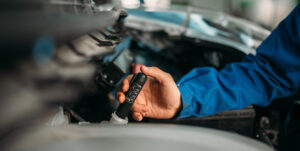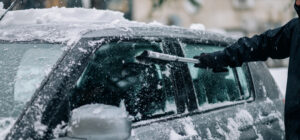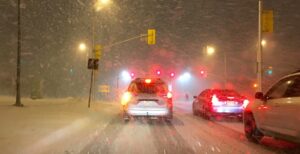As winter approaches and the average temperature begins to drop, St. Louis drivers should prepare for driving in snowy and icy conditions. According to the Missouri Department of Transportation (MoDOT), the frequency of car and truck accidents increases during the winter months, usually peaking in December. That’s why we are going to share these quick safety tips for driving in snow and ice.
According to the Federal Highway Administration, 24% of weather-related vehicle crashes occur on snowy, slushy or icy pavement each year and 15% happen during snowfall or sleet. To minimize the risk of getting into a car accident, we’ve put together a few quick safety tips for driving in snow and ice.
Missouri Winter Weather Conditions
Winter driving can be especially hazardous in Missouri due to our climate. Our winters are cold but don’t normally drop below freezing and we don’t normally receive heavy snowfall. We do, however, experience sleet and ice storms which are often considered more dangerous than snow.
An ice storm is a weather phenomenon where freezing rain falls and forms a layer of ice on surfaces such as roads, trees, and power lines. Ice accumulates on surfaces, making them slick and dangerous to travel on.
Ice storms can be very dangerous for drivers as they create extremely hazardous road conditions. The ice that forms on roads and highways can cause vehicles to skid and slide, making it difficult for drivers to maintain control of their vehicles. In addition, ice can accumulate on windshields and make it difficult to see the road and other vehicles. Ice storms can also cause power outages as the weight of the ice can cause trees and power lines to fall. This can lead to dangerous situations for drivers, as traffic lights may not be working, and downed power lines can pose a serious hazard.
Click here for live weather updates for the St. Louis area.

Quick Tips For Driving In A Snow Or Ice Storm
- Drive Slowly And Carefully. Avoid sudden movements or braking,
- Leave Plenty Of Space. Make sure to leave space between your vehicle and the vehicle in front of you
- Use Your Headlights. This will help improve visibility.
- Stay Inside. If possible, it is best to avoid driving during a snow or ice storm altogether and wait until conditions improve.
Inspect Your Vehicle In The Fall
Inspecting your vehicle is important to ensure that it’s prepared to handle hazardous driving conditions. You’ll want to do this in the fall before winter weather hits. We’ve outlined which parts of your vehicle to check to help reduce the risk of accidents and breakdowns.
Quick Tips For Inspecting Your Vehicle
- Check Fluids. Make sure your car fluids, such as engine oil and wiper fluid, are at the proper levels. Pay close attention to the fluid levels for your antifreeze and power steering reservoirs and make sure they haven’t frozen over. If your power steering fluid is below an optimal level, your ability to steer could be severely impaired.
- Check Tires. Make sure the tread and sidewalls of your tires aren’t too worn-down or damaged. Also, keep in mind that tire pressure naturally decreases with the temperature. When temperatures drop to freezing levels, you can expect your tires to be under-inflated by 2-5 psi. When this happens, you should inflate your tires to the recommended pressure for your car.
- Check Windshield Wipers. Effective windshield wipers are an essential part of driving in extreme winter conditions. Your car’s wipers will wear out faster during the winter because the cold makes the rubber more brittle. Unless you already replaced your windshield wipers in the past 6 months, you should start winter with a fresh set of wipers. If you are leaving your car outside overnight, make sure to extend your windshield wipers out, so they aren’t touching the glass. Otherwise, the wipers will freeze on your windshield. You may be forced to scrape them out of the ice, likely damaging the rubber in the process.
You can choose to do these inspections yourself or take your vehicle to a trusted auto shop. Most auto shops provide a “winterization” or “winter prep” service that will fully prepare your car for winter weather.

Properly Prep Your Car For Driving In Snow And Ice
Preparing your car for winter driving is crucial. You should never jump into your car and immediately start driving after a snow or ice storm. Always take time to properly prep your vehicle for a safer and smoother ride.
Quick Tips For Winter Vehicle Prep
- Let Your Car Run For A Couple Of Minutes. Start your engine and let it warm up until your temperature gauge approaches a moderate temperature. Engine oil thickens in cold temperatures, neutralizing its lubricative properties. As a result, driving your car before your fluids reach a moderate temperature could put undue strain on your vehicle.
- Clear Off Snow And Ice. Take the time to thoroughly clear snow and ice from the following areas:
- The Windshield. Don’t rely on your wipers to clear off the snow. Your wipers will be ineffective against thick ice. Rough ice can potentially damage your wipers.
- Headlights. If your lights are obstructed by ice and snow, they will emit only a faint glow. As a result, you will have a difficult time seeing what’s in front of you, and others will have an equally hard time seeing you.
- Brake Lights. Without brake lights, drivers behind you won’t be able to tell if you are decelerating.
- The Surface Of Your Hood, Trunk, And Roof. If you do not clear off these surfaces before you start driving at highway speeds, any remaining ice chunks will come soaring toward neighboring cars at a dangerous speed.

Driving Your Vehicle In Snow and Ice
Once your vehicle has been properly inspected and prepped, it’s finally time to hit the road. It’s important to note, however, that despite taking all the necessary steps listed above, it’s still risky to drive in snow and ice. You’ll need to be extra cautious to avoid weather-related hazards.
Quick Tips For Driving In Snow And Ice
- Drive Slower. If you find yourself driving at the same speeds you would in dry weather conditions, you are probably exceeding the safe driving speed by 10 mph. Driving slowly gives you more time to respond to hazards.
- Avoid Ice Patches. In near-freezing weather conditions, a thin layer of water will develop across the surface of the ice, which will significantly reduce the friction between your tires and the road (a phenomenon known as “hydroplaning”). When your car encounters a hydroplane, it is no different than if your vehicle left the ground and went flying in mid-air.
- No Sudden Maneuvers. If you drive through an ice patch, try not to abruptly correct your steering at an exaggerated degree or suddenly decelerate or accelerate. If you attempt to break or accelerate, you could end up losing control and hydroplaning. Your car will continue moving in the direction of its momentum at the time it entered the hydroplane.

Other Important Tips
- Plan To Leave Earlier. You can easily plan for driving in weather conditions. By leaving 15 to 20 minutes earlier than you usually would, you give yourself room to drive at a safer speed. Departing earlier prevents you from rushing so you do not feel the need to drive faster.
- Supplies. Make sure you have snow-clearing equipment in your car at all times, including a snow shovel, a windshield scraper, and a brush for your side-view mirrors. Keep blankets, water, non-perishable food, and a first aid kit in case you become stranded or injured in a crash that renders your car inoperable.
What To Do If You Get In An Accident
Following these tips for driving in snow and ice will help prevent car accidents. However, we can’t say the same for other drivers. If the negligence of another driver results in an unavoidable accident, you should hire an experienced St. Louis personal injury attorney to help obtain just recompense for any injuries you sustain.
At Cantor Injury Law, we have years of experience handling car accident cases. Our clients can rely on our tremendous skill and sophisticated understanding of accident litigation to seek compensatory damages from those responsible for injury-producing accidents.
FAQs: Quick Safety Tips For Driving In Snow And Ice
Q: Why Is Driving In Snow And Ice Hazardous?
A: Driving in snow and ice can be dangerous due to reduced traction and visibility. Slippery road conditions can cause vehicles to skid and slide, making it difficult to maintain control. Ice storms, in particular, create extremely hazardous road conditions and can lead to accidents and power outages.
Q: What Are Some Quick Tips For Driving In A Snow Or Ice Storm?
A: Here Are Some Quick Tips For Driving In A Snow Or Ice Storm:
- Drive slowly and carefully, avoiding sudden movements or braking.
- Leave plenty of space between your vehicle and the one in front of you.
- Use your headlights to improve visibility.
- If possible, avoid driving during a snow or ice storm and wait until conditions improve.
Q: What Should I Inspect On My Vehicle Before Driving In Winter Weather?
A: Before Driving In Winter Weather, It’s Important To Inspect Your Vehicle. Here Are Some Areas To Check:
- Fluids: Ensure your car fluids, such as engine oil and wiper fluid, are at proper levels. Check antifreeze and power steering fluid to ensure they haven’t frozen over.
- Tires: Check tire tread, sidewalls, and pressure. Inflate your tires to the recommended pressure for cold temperatures.
- Windshield Wipers: Replace worn-out wipers and extend them away from the windshield to prevent freezing.
Q: How Should I Properly Prepare My Car For Driving In Snow And Ice?
A: To Prepare Your Car For Driving In Snow And Ice, Follow These Tips:
- Let your car run for a few minutes to warm up the engine.
- Thoroughly clear snow and ice from your windshield, headlights, brake lights, hood, trunk, and roof.
- Ensure all surfaces are clear to avoid visibility issues and flying ice chunks while driving.
Q: What Are Some Additional Tips For Driving In Snow And Ice?
A: Here Are Some Additional Tips For Driving In Snow And Ice:
- Drive slower than usual to allow for increased response time.
- Avoid ice patches and hydroplaning by driving cautiously and avoiding sudden maneuvers.
- Plan to leave earlier to avoid rushing and driving at unsafe speeds.
- Keep necessary supplies in your car, such as snow-clearing equipment, blankets, water, non-perishable food, and a first aid kit.


